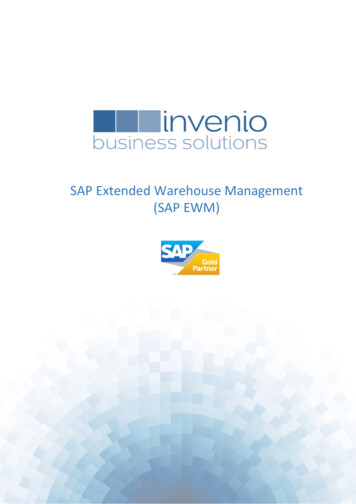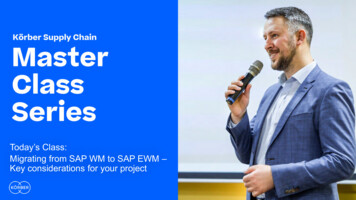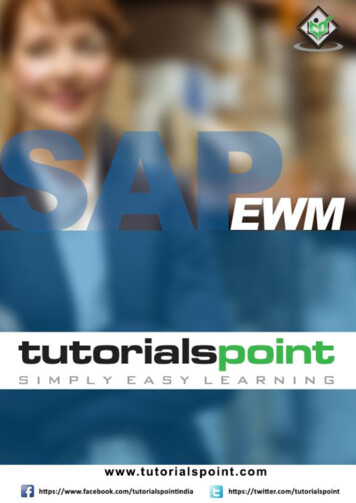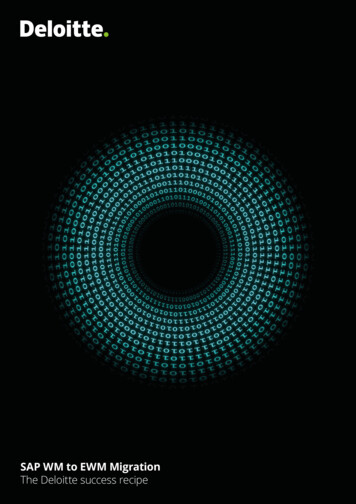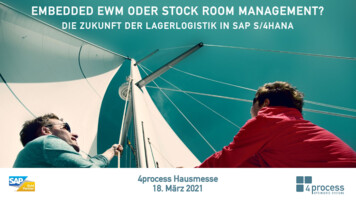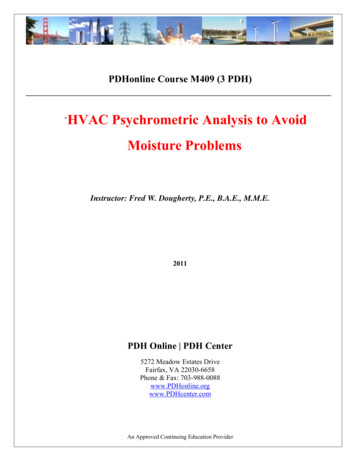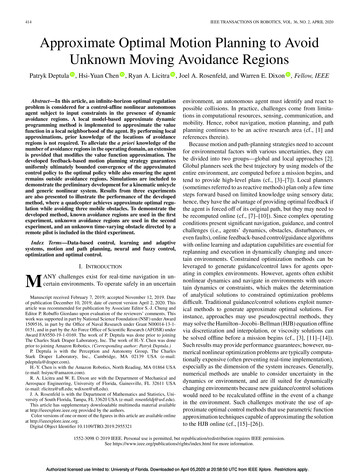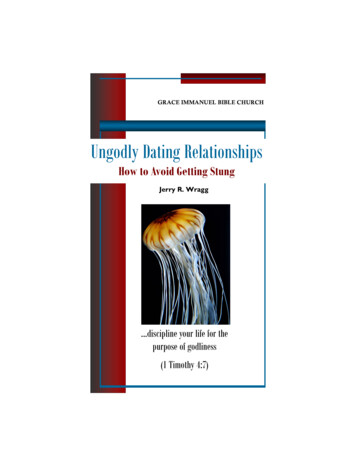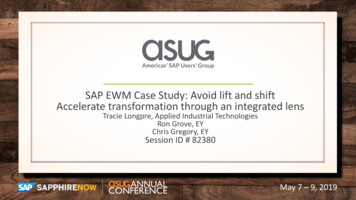
Transcription
SAP EWM Case Study: Avoid lift and shiftAccelerate transformation through an integrated lensTracie Longpre, Applied Industrial TechnologiesRon Grove, EYChris Gregory, EYSession ID # 82380May 7 – 9, 2019
Agenda About the speakers Applied Industrial Technologies overview Building the business case for SAP EWM‒ Software evaluation, business benefits, ROI Avoid “lift and shift”— Focus on supply chain operating pillars Warehouse operational improvement assessment – key findings Deployment plan/agile approach Lessons learned Q&A
About the speakers:Tracie LongpreVice President, Supply ChainApplied Industrial TechnologiesSupply Chain;2 SAP Projects;Procurement201420071999MBADom (16)1994FinanceRetail1992SalesFinanceBBA Operations MgtSupply ChainMia (10)Coco (5)
About the speakers - EYChris GregoryEYSAP Digital Supply Chain LeaderRon GroveEYDigital Logistics & Fulfilment LeaderChris has more than 25 years of combined supply chain,distribution and logistics advisory experience across a widevariety of industries and clients. He has spent the last 15years focused on SAP supply chain execution and planning,logistics, transportation and enterprise mobility. Hisexperience spans consulting practice management,business development and client delivery. Prior to joiningconsulting, Chris spent nine years with a wholesaledistributor in the media and entertainment industry.Ron is focused on enabling high performance logistics operationsand has over 20 years of focused consulting experience workingacross a broad array of industries. Ron has vast experience inDistribution Center (DC) design, warehouse process optimization,material handling equipment layout, design and specification, aswell as strategic slotting, engineered labor standards and variouslabor management software solutions. He also has experience inthe procurement and implementation of material handlingequipment and technologies.Mobile: 1 215 630 4213 Christopher.gregory@ey.comPhiladelphiaMobile: 1 773 230 6349 ron.grove@ey.comChicago
Key outcomes/objectives1.2.3.Hear how Applied leveraged a combination of business, ITand strategic factors to build a business case for SAPExtended Warehouse Management (EWM)Learn how Applied avoided a “lift and shift” approach todeploy a step change transformation across their supplychainUnderstand key lessons learned and how organizations canoptimize their operations
Applied Industrial Technologies overviewA leading value-added distributor of bearings, power transmission products, engineeredfluid power components and systems, specialty flow control solutions and other industrialsupplies serving customers in virtually every industry.95 years6,600 associates 600 locations of expertise andgrowingmore than half arecustomer-facing24/7 service6.5m SKUs
Current Applied supply chain network7 US-based DCs inscope for EWM- 6 on legacy WMS- 1 DC completelymanual processes(MSS)- Average DC Size110,000 sq ft w/35K SKUs and 17m in inventoryMSS, OH
Building the business case for SAP EWM Six distribution centers operating a 20 year oldlegacy WMS solution‒ Highly customized and very expensive tomodify Current WMS lacks advanced functionality‒ No Labor management, cross-docking, slotting One paper-based DC with current distributioncost as a percent to sales is greater than 10%‒ The goal is to lower distribution cost to lessthan 2.5% cost of salesThe net result of these combined factors identified a business case withsignificant annual savings
Building the business case – WMS softwareevaluationCore capabilityWtCore capabilityWtTool sophistication/ease of use2Kitting standard2Inbound receiving2Picking/Wave management2Cross-docking2Replenishment2Quality inspection process2Packing/shipping2Put-away management2Reporting – dashboards, KPIcentric, many standard offeringsReturns processing2Slotting capabilities4Labor management standard4Ship manifest integration4Cycle counting2UOM Management2Interleaving standard4Cost implementationWtCost for softwareimplementation and on-goingmaintenance is competitive10Payments are milestone/delivery-based5Implementation ease(time and complexity)5SubtotalSeamless /touch-free SAPintegration5Customization SAP integrationWt5Ship manifestintegration5Infrastructure5Batch processingBackorder processingHardware for users atDCAdditionalSubtotal4431238VendorWtYears in business0.5No significant cautions in Dunnand Bradstreet Report orfinancial statement notes0.5Consistent financial positionover last three years0.5 CostEquity/Asset at least 30%; equity/debt at least 50%0.5 FunctionalityPercentage of allocated toR&D for product0.5Reference sites provided0.5Guaranteed response time(e.g., customer representativeresponds with either fix oraction plan) within 24 hours0.5Additional9.5Subtotal13Recommendation: Spend time to identify keyselection criteria – objectively score card resultsSAP EWM selectedbased on: Technical integration Strength in company
Building the business case – SAP EWM benefitsBenefitLabormanagementCrossdockingCurrent WMS situationSAP EWM Labor management solution is aseparate module. Requires newsoftware license purchase and highintegration costs. 10 – 15% productivity improvement with individualemployee tracking Fosters proactive coaching/mentoring environment;improves employee satisfaction Systemic capability does not exist Off-line manual process Systemic movement of inbound freight to propershipping lanes - DC to DC; DC to SCs Receiving efficienciesRobustreportingFlexible UOMs Basic Access database Reporting with silo ownership Standard network reporting, cockpits and exceptionreporting Empowered DC management Only one UOM (EA) is available today Expand limit of one UOM (EA) to various UOMs Improve picking accuracy with UOM pickingdifferentiation – 1 EA means 1 EA or 1 EA means 1 CS Tribal knowledge used to determinepick UOM
Building the business case - Labor managementdrives productivity and costs savingsLabor management program savings can be significant*Engineered standard at 100% performance baselineOn average, labor represents 65% of annual distribution center costs.An integrated labor management program can drive significantopportunities to reduce costs and optimize performance.(Sample)
Building the business case – SAP EWM benefitsBenefitCurrent situationSAP EWMSlottingoptimization Systemic capability does not exist Off-line manual process Verify ideal placement/storage of parts in the DC Drive efficiency in picking and receivingQuality audit/lot control Limited lot control/formal qualityinspection functionality Enable part inspections and part lot control functionalityDC redesignsupport Limited in ability to integrate withnewer technology Expanded functional capabilities to enable operational maturity Integral machine control capabilities and ability to supportintegration with new warehouse control systems and othertechnology, such as native SAP connectivity through MFSShip manifestinterface No standard linkage to outsidemanifest system Estimated 500K customization costto interface Support technical customer requirements or federal regulations Move to one uniform manifest system Avoid current state implementation costs with standard linkages Eliminate dual maintenance and support
Building the business case – SAP EWM benefitsBenefitCurrent situation Systemic capability does not exist Pick directly into right-sized shipping cartons Eliminate double handling Systemic capability does not exist Build part kits from open stock (standard or customer specified) Limited task interleaving capability More sophisticated interleaving Assign multiple roles while traveling in the warehouse(i.e. pick and put-a-way) driving efficiency and improved cycle timeCartonizationKittingAdvanced taskinterleavingSAP EWM
Building the business case – SAP EWM benefitsSAP landscape Leverage overall SAP landscape – end-to-end digital supply chainReal-timeintegration Enable real-time integration and access to SAPReduction ininterfacesupport Reduction in interface development, support and ongoing maintenanceEnterprisevisibility Drive enterprise visibility of inventory, activities and metrics Reduce order processing down-time due to integration gapsUpgrade costs Reduce costs for enhancements and upgrades by eliminating reliance on third parties Lower upgrade cost by leveraging internal system supportVendor viability Long-term vendor viability and support. Current WMS solution is no longer offeredin the market
Building the business case – SAP EWM benefitsvs. paper-based manual environmentBasic WMS functionality deliveredSystem-guidedstrategies Optimize the routing in areas such as put-away, replenishment andpick pathsResourcevisibility Resource and manpower planning and managementSpaceoptimization Multiple bin support to optimize warehouse space and productivityBetter controlsRF directedworkKey benefits Productivity Space utilization Cycle time Throughput Accuracy Reduce the possibility of lost product and write-offs Real-time transactions to match the physical process;timely visibility for allocation, purchasing, warehouse operations andcustomer serviceOptimizing the paper-based DC drove 50% of annual savings/ROI
Building the business case – ROI validation2018201920202021Pilot: Includes network design, build andtestingCarlisle, PAFontana, CAMinimal external consultingsupport for post pilot rolloutsPortland, ORStrongsville, OHAtlanta, GAFt Worth, TXFlorence, KY Business case validation identifiedsignificant annual savings post rollout ROI less than three years Phased rollout vs. big-bang approachto reduce risk Applied would support site rolloutsafter pilot deploymentStrongsville, OH currentlypaper-based50% of ROI case
SAP EWM project charter The pilot phase deployment plan and approach assumes an enterprisewide EWM solution template design for all seven in-scope sites, withinput and feedback from stakeholders across Applied supply chain Deploy a stable, fully tested EWM solution for the pilot site, with fullytrained users (including IT staff) and minimal business disruption Leverage leading practices and standard EWM functionality toachieve results with minimal solution customizations andenhancements Leverage lessons learned from the pilot site rollout for additional siterollouts with minimal additional support
SAP EWM consulting partner evaluationEYOtherTimelineEY recommended a longer timeline, partially to de-risk the engagement, but alsoincorporated additional knowledge transfer, training and hyper-care support forincreased Applied self-sufficiency for future site rollouts.CostMinimal price differentialCompany stability EY had acquired the leading SAP EWM partners in North America and EMEA EY has established track record in SAP EWM deployments Stable leadership team and strong financial foundationExperience EY has been involved with EWM since solution inception in 2005 Supported hundreds of EWM deployments globally Global breadth and depth of EWM practice SAP EWM integration with SAP S/4CapabilitiesWarehouse Operational Improvement Program, integrated supply chain lens,significant number and variety of client experiences and overall capabilitiesEY was selected due to these primary factors – more experience,stronger embedded learning and support and less risk.
Avoid “lift and shift” – focus on key supply chainpillarsCost and qualityPeople Labor scheduling andplanning Labor visibility Accountability HR and safety policiesProcess Floor level activities Facility layout Work planning and release Material handlingequipment Supporting activities(i.e., inventory control)TechnologyEnvironment Adjacencies and flow Functionality to enablefuture processes Administrationrequirements and supportHigh performing operationLeverage best practices first SAP EWM helpssynchronize the pillars
EWM AlignmentWarehouse operational improvement programAn SAP EWM implementation should be viewed through the lens ofbest practices to achieve better results.
WOIP key findings and recommendationsStrongsville – 100 findingsCarlisle – 100 mpactHighHighMedLow141512Low Change pick and put-awaypath Add case flow rack aroundperimeter Carts to support multiplelines per bin/carton Batch pick waves by SCExample: 25% sidentifiedacross safety,quality,productivity,and costsavings
Hybrid agile implementation approachStart smart,scale fast,adapt andimprove quickervalidation leadsto reduced risk
Pilot site deployment plan – 10-month timelineSeptOctNovDecJanFebMarAprMayJulJunWOIP – 5 wksDesign / Agile – 23 wksBuild – 8 wksTest – 8 wksKickoffTraining3 wksDeployCarlislego-liveSupportOrganizational change managementScope EWM to ECCintegration Inbound labeling Wavemanagement Transportation units Block/unblock Interleaving Internal transfers/scrapping Master data Put-awaystrategies Standard inboundprocessing Returns Receiving Cross-docking Overages/shorts/damages Standardoutboundprocessing Staging/loading Shipping Inventorymanagementprocessing Delivery creation Outbound labeling Bin to bin Unloading/staging Picking/pickingstrategies Packing/repacking Process-orientedstorage Exception processing Inventory counting Labor management Serial numbermanagement Trans-ships/ Speedpack Standardreplenishment Batch management RF processing Physical inventory/cycle count Slotting andrearrangement Queue and resourcemanagement Batch management
Dedicate key resources and combine with strongprogram governanceProject steering committee Executive sponsor – VP supply chainPresident & CEOChief financial officerVP Information technologyVP Operational excellenceProgram directorEY Engagement partnerMonthly meetings
Building the business case –SAP EWM benefits vs. paper-based manual environment Resource and manpower planning and management Multiple bin support to optimize warehouse space and productivity System-guided strategies Resource visibility Space optimization Optimize the routing in areas such as put-away, replenishment and pick paths Reduce the possibility of lost product and write-offs Real .
